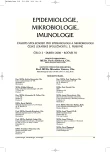West Nile Virus
Authors:
Š. Lásiková; L. Moravcová; D. Pícha; B. Horová 1
Authors‘ workplace:
1. infekční klinika FN Na Bulovce, Praha
; OKM FN Na Bulovce, Praha
1
Published in:
Epidemiol. Mikrobiol. Imunol. 55, 2006, č. 2, s. 59-62
Overview
West Nile virus (WNV) is a member of the Flaviviridae family, genus Flavivirus. Its reservoir hosts are wild birds. Infection is transmitted to humans by infected mosquitoes of the genus Culex. In most cases, it is either asymptomatic or manifests itself as mild fever. Typically, WNV illness has a sudden onset with fever above 39 °C and accompanying symptoms such as chills, headache, arthralgia, myalgia, back ache, cough and sore throat. Gastrointestinal symptoms are frequently reported. Generalized lymphadenopathy and conjunctivitis may develop. In some patients the infection can progress to meningoencephalitis. Diagnosis is currently based on detection of IgM antibodies in blood and cerebrospinal fluid or direct detection of WNV RNA.
Key words:
West Nile virus – West Nile virus fever.
Labels
Hygiene and epidemiology Medical virology Clinical microbiologyArticle was published in
Epidemiology, Microbiology, Immunology

2006 Issue 2
Most read in this issue
- West Nile Virus
- Medium with Amikacin for Laboratory Diagnosis of Beta-haemolytic Streptococci
- Outbreak of Marburg Hemorrhagic Fever in Angola
- Epidemiological Characteristics of Diabetes Mellitus in Slovakia, 1992–2002
